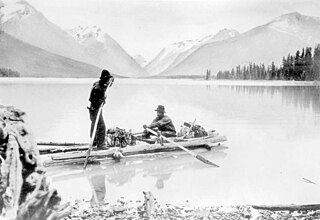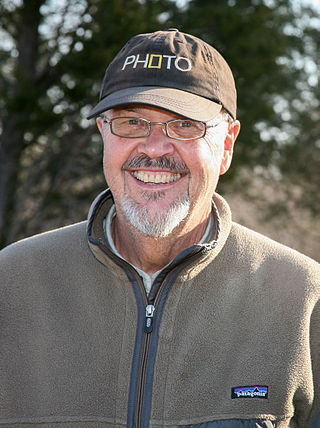Galen Avery Rowell was a wilderness photographer, adventure photojournalist and mountaineer. Born in Oakland, California, he became a full-time photographer in 1972.

The Stikine River is a major river in northern British Columbia (BC), Canada and southeastern Alaska in the United States. It drains a large, remote upland area known as the Stikine Country east of the Coast Mountains. Flowing west and south for 610 kilometres (379 mi), it empties into various straits of the Inside Passage near Wrangell, Alaska. About 90 percent of the river's length and 95 percent of its drainage basin are in Canada. Considered one of the last truly wild large rivers in BC, the Stikine flows through a variety of landscapes including boreal forest, steep canyons and wide glacial valleys.

The Skeena River is the second-longest river entirely within British Columbia, Canada. Since ancient times, the Skeena has been an important transportation artery, particularly for the Tsimshian and the Gitxsan—whose names mean "inside the River of Mist" ,and "people of the River of Mist," respectively. The river and its basin sustain a wide variety of fish, wildlife, and vegetation, and communities native to the area depend on the health of the river. The Tsimshian migrated to the Lower Skeena River, and the Gitxsan occupy territory of the Upper Skeena.

The Tahltan or Nahani are a First Nations people of the Athabaskan-speaking ethnolinguistic group who live in northern British Columbia around Telegraph Creek, Dease Lake, and Iskut. The Tahltan constitute the fourth division of the Nahane.
The WILD Foundation is a 501(c)(3) organization that was founded in 1974 by two South Africans and based in Boulder, Colorado.

Dewitt Jones is an American professional photographer, writer, film director and public speaker, who is known for his work as a freelance photojournalist for National Geographic and his column in Outdoor Photographer Magazine. He produced and directed two films nominated for Academy Awards: Climb (1974), nominated for Best Live Action Short Film, and John Muir's High Sierra (1974), nominated for Best Short Subject Documentary. He has published several books.

The Beaver Dam Mountains Wilderness is a wilderness area located in northwestern Arizona and southwestern Utah, USA, within the arid Colorado Plateau region. The jagged mountains and gently sloping alluvial plain of the Beaver Dam Mountains straddle the border between the two states. The Wilderness contains some of the lowest elevation land in Utah, and includes a 13 miles (21 km) section of the Virgin River Gorge. The area comprises some 18,667 acres (7,554 ha), 15,000 acres (6,100 ha) of which in Arizona and approximately 3,667 acres (1,484 ha) in Utah. The area was designated Wilderness by the U.S. Congress in 1984 and is administered by the Bureau of Land Management.
Spatsizi Plateau Wilderness Provincial Park is located in the northern portion of British Columbia, Canada, approximately 698, 659 hectares and encompasses the Spatsizi River and Gladys Lake Ecological Reserve. The park is a designated protected area that is intended for the conservation and research on caribou, grizzly bears, fish, and other wildlife species populations. Before the provincial park's establishment in 1975, the area was a historical hunting ground for local Indigenous communities like the Tahltan First Nations.It is the second largest provincial park in British Columbia.
Philip Hyde (1921–2006) was a pioneer landscape photographer and conservationist. His photographs of the American West were used in more environmental campaigns than those of any other photographer.
Jim Brandenburg is an environmentalist and nature photographer and filmmaker based near Ely, Minnesota. His career includes over 10 years as a newspaper photojournalist, over 30 years as a contract photographer for the National Geographic Society, and commissions from such groups as the United States Postal Service, NHK and the BBC.

Cristina Goettsch Mittermeier is a Mexican photographer, conservationist, biologist, and author.

The Sacred Headwaters is a large subalpine drainage basin centred around Klappan Mountain of the Klappan Range in northern British Columbia. It is the source of three wild salmon rivers: the Skeena River, Nass River, and Stikine River. It is also referred to as the Klappan Valley, although the Klappan—a tributary of the Stikine River—is only one of the area's watersheds. Local Tahltan people call the area Klabona, which is loosely translated as "headwaters".
John Fielder was an American landscape photographer, nature writer, the publisher of over 40 books, and a conservationist. He was nationally known for his landscape photography, scenic calendars and for his many coffee table books and travel guides—including Colorado's best-selling Colorado 1870–2000, in which he matched the same scenes of classic photographs taken in the 19th century by photographer William Henry Jackson.
The Klappan Coalbed Methane Project is a gas project owned by Shell Canada that looks to develop the coalbed methane from an area in northern British Columbia, near the source of three rivers: the Skeena River, Nass River, and Stikine River, and also the namesake Klappan River. The area is known in environmental politics and native lore as the Sacred Headwaters or Kablona. The project is the source of controversy and is opposed by First Nations groups and non-governmental organizations. If developed, the project will include a network of gas wells connected by roads and pipelines, as well as a pipeline to deliver the gas to market.
Sierra Club Books was the publishing division, for both adults and children, of the Sierra Club, founded in 1960 by then club President David Brower. They were a United States publishing company located in San Francisco, California with a concentration on biological conservation. In 2014 the adult division of the organization was sold to Counterpoint LLC and the children's books division to Gibbs Smith.
Amy Gulick is an American nature and wildlife photographer. She is one of the founding Fellows of the International League of Conservation Photographers

Jack William Dykinga is an American photographer. For 1970 work with the Chicago Sun-Times he won the annual Pulitzer Prize for Feature Photography citing "dramatic and sensitive photographs at the Lincoln and Dixon State Schools for the Retarded in Illinois."
Colorado 1870–2000 is a pictorial history of frontier Colorado consisting of repeat photography by photographers William Henry Jackson and John Fielder. This book is also a collaboration with the Colorado Historical Society.
Boyd Norton is an American photographer, known for his work in wilderness photography and his environmental activism. He is the photographer/author of 17 books covering topics such as from African elephants, mountain gorillas, Siberia's Lake Baikal and issues of Alaskan and Rocky Mountain conservation. He contributed photographs to the Environmental Protection Agency's Documerica project in the early 1970s.
Bart Smith is an outdoor photographer who concentrates on documenting America's National Trails System. Over the course of more than 25 years, he became the first person to hike and photograph all of the 11 national scenic trails and to traverse all of the 19 national historic trails. The 30 national trails go through all 50 states, with a total mileage of more than 50,000 miles.








